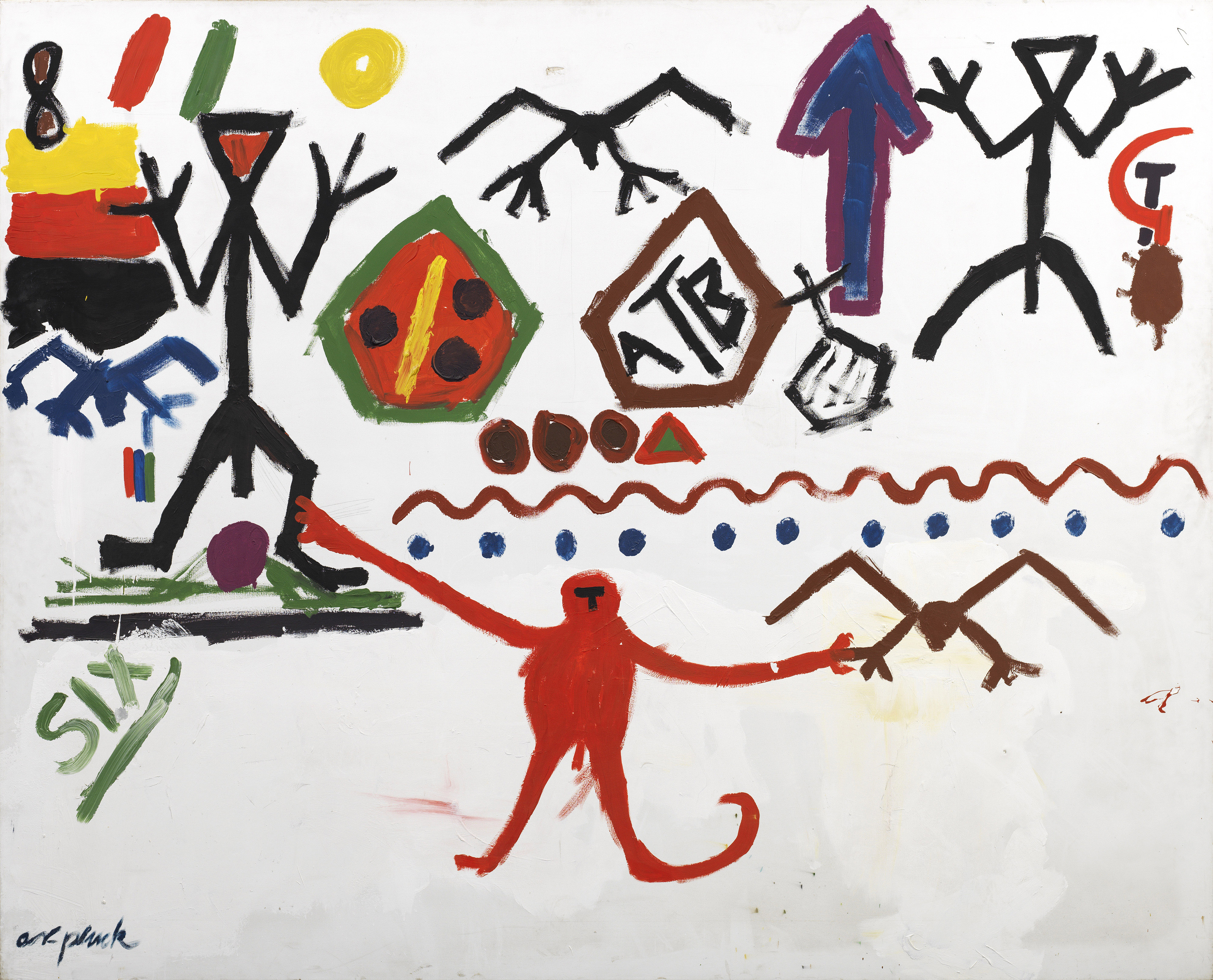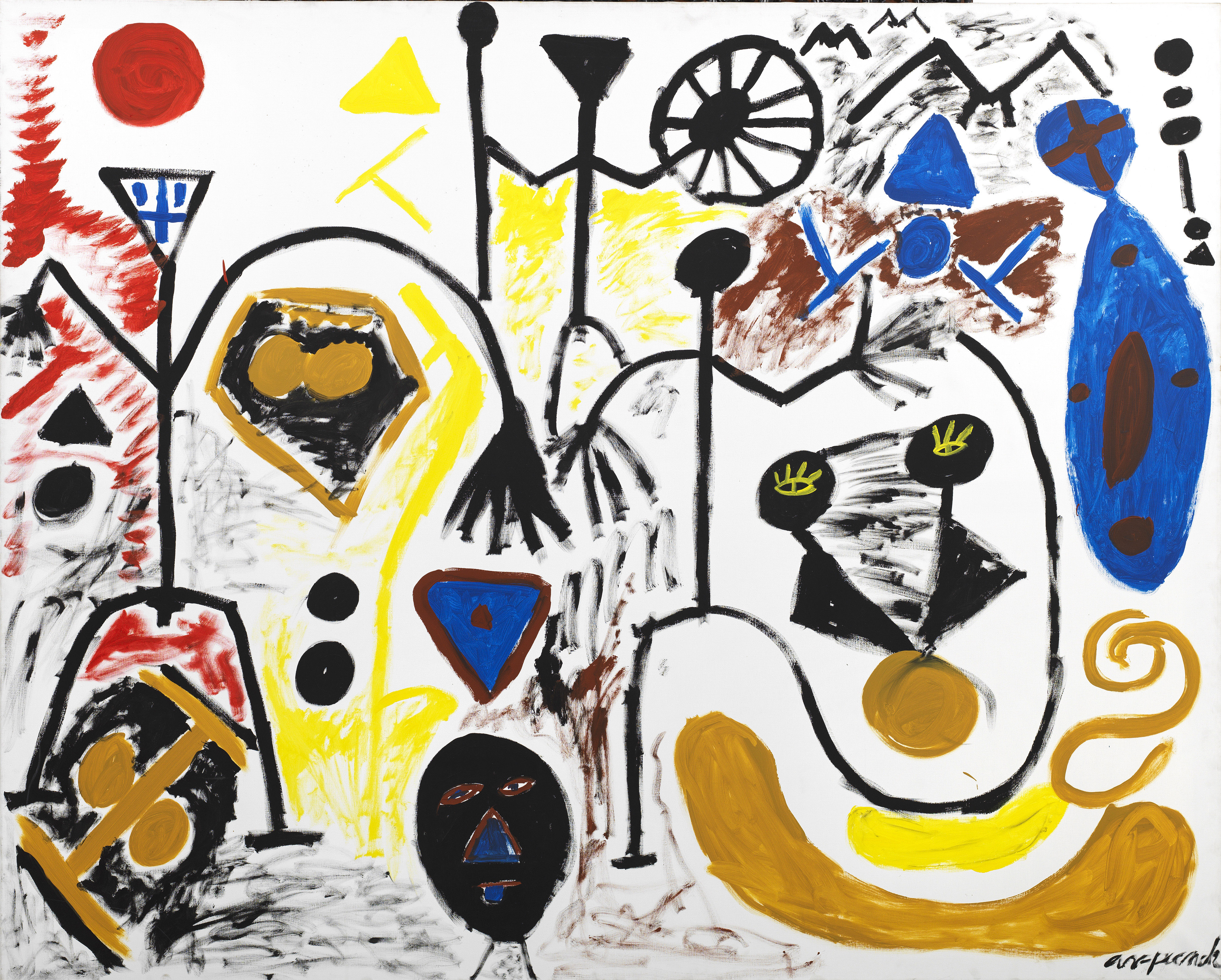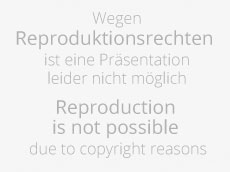A.R. Penck Follow Untitled signed 'ar. penck' lower left acrylic on canvas 99.4 x 80 cm (39 1/8 x 31 1/2 in.) Painted in 1973.
Provenance Galerie Kunstraum Angermund, Dusseldorf Private Collection, Rome Catalogue Essay ‘This is a big word, violence, but for art (and in particular painting and sculpture) to continue to exist in the brave new world of explosive electronic imagery, such aggression is necessary, in content and manufacture….The behaviour of Penck’s art is certainly brash and boisterous and aggressive. That is why, somehow, he has been one of our great tough and unconventional contemporaries who, just by being there, has paved the way for some of our younger ones such as Damien Hirst and Julian Schnabel’. (Rudi Fuchs in A. R. Penck, Die Achtziger Jahre , exh. cat., Julius Werner, Berlin, 23 February – 27 March 2008, n.p.) A.R. Penck, one of Germany's most celebrated artists, utilised an iconic primal, semi-abstract style which has made his simple yet confrontational imagery instantly recognizable on an international stage. Within the artists of the Neue Wilden movement, who found motivation in mythology, figuration and bright, brash tones, Penck’s continued use of intense colour and hasty, broad brushstrokes set him apart from dominant avant-garde aesthetics. From the onset Penck set himself apart, pursuing an intense interest in developing a system to unite art and language whilst addressing complex socio-political themes. His childhood preoccupation with science fiction encouraged a deeper reading into the workings and implications of information theories and cybernetics. Subsequently, this concern began to be reflected in his prolific output of work and the stick figure, recognisable in many of his paintings, became a motif of a new system of communication that combined text, symbol and image. The primitive, innovative and cave-like drawings challenged and unsettled notions about the nature of modernist contemporary art. Herewith Penck activated a new and exciting attempt to destabilise the censorship he had faced from the German Democratic Republic. The following selection of works, executed throughout the 1970s and 1980s, offers an insight into Penck’s unswerving preoccupation with what became known as Standart; a fake alphabet of sorts that the artist himself designed. The loose capricious configuration of curving lines and figures of Belagerung und Einnahme Von Beirut I at first appear random and confused, yet Penck employed them with such clarity and vigour that they expressively work beyond the specifics of narrative. The hectic swaying movement of tall, elongated stick figures is surrounded by various objects and crudely rendered animals, pictograms and calligraphic squiggles, tumbling and plunging across the canvas, many of them inverted. The motion captured within the painting conjures monumental energy; the hidden, arcane references elude the spectator whilst rousing a sense of familiarity. Whilst the execution of the paintings may appear fairly rough, as Penck’s sense of conviction grew so did the boldness of his work. In both Untitled works, the bold brushstrokes and expressive shapes sit affront the dimensionality of the canvas whilst the stick figures engulf the picture, growing stronger and more powerful. The sense of movement within each painting becomes almost fevered as the figures wildly jump, dance or fight. Penck delicately dismantles the mysteries of preconceived notions of artistic creation; the washes of vibrant greens, reds, blues and blacks in Untitled are added in violent, almost explosive bursts. Charismatic and dynamic, the present works are highly communicative. In devising suggestive narrative scenes, the present selection spanning a decade of the artist’s oeuvre attempts to find a universal language - one that could address the trauma, sadness, and loss that followed the Second World War whilst also affecting viewers beyond Germany. Reviving painting as a crucial practice for communication, Penck has become synonymous with a painting style that is figurative whilst fuelled with relevant social and politica
A.R. Penck Follow Untitled signed 'ar. penck' lower left acrylic on canvas 99.4 x 80 cm (39 1/8 x 31 1/2 in.) Painted in 1973.
Provenance Galerie Kunstraum Angermund, Dusseldorf Private Collection, Rome Catalogue Essay ‘This is a big word, violence, but for art (and in particular painting and sculpture) to continue to exist in the brave new world of explosive electronic imagery, such aggression is necessary, in content and manufacture….The behaviour of Penck’s art is certainly brash and boisterous and aggressive. That is why, somehow, he has been one of our great tough and unconventional contemporaries who, just by being there, has paved the way for some of our younger ones such as Damien Hirst and Julian Schnabel’. (Rudi Fuchs in A. R. Penck, Die Achtziger Jahre , exh. cat., Julius Werner, Berlin, 23 February – 27 March 2008, n.p.) A.R. Penck, one of Germany's most celebrated artists, utilised an iconic primal, semi-abstract style which has made his simple yet confrontational imagery instantly recognizable on an international stage. Within the artists of the Neue Wilden movement, who found motivation in mythology, figuration and bright, brash tones, Penck’s continued use of intense colour and hasty, broad brushstrokes set him apart from dominant avant-garde aesthetics. From the onset Penck set himself apart, pursuing an intense interest in developing a system to unite art and language whilst addressing complex socio-political themes. His childhood preoccupation with science fiction encouraged a deeper reading into the workings and implications of information theories and cybernetics. Subsequently, this concern began to be reflected in his prolific output of work and the stick figure, recognisable in many of his paintings, became a motif of a new system of communication that combined text, symbol and image. The primitive, innovative and cave-like drawings challenged and unsettled notions about the nature of modernist contemporary art. Herewith Penck activated a new and exciting attempt to destabilise the censorship he had faced from the German Democratic Republic. The following selection of works, executed throughout the 1970s and 1980s, offers an insight into Penck’s unswerving preoccupation with what became known as Standart; a fake alphabet of sorts that the artist himself designed. The loose capricious configuration of curving lines and figures of Belagerung und Einnahme Von Beirut I at first appear random and confused, yet Penck employed them with such clarity and vigour that they expressively work beyond the specifics of narrative. The hectic swaying movement of tall, elongated stick figures is surrounded by various objects and crudely rendered animals, pictograms and calligraphic squiggles, tumbling and plunging across the canvas, many of them inverted. The motion captured within the painting conjures monumental energy; the hidden, arcane references elude the spectator whilst rousing a sense of familiarity. Whilst the execution of the paintings may appear fairly rough, as Penck’s sense of conviction grew so did the boldness of his work. In both Untitled works, the bold brushstrokes and expressive shapes sit affront the dimensionality of the canvas whilst the stick figures engulf the picture, growing stronger and more powerful. The sense of movement within each painting becomes almost fevered as the figures wildly jump, dance or fight. Penck delicately dismantles the mysteries of preconceived notions of artistic creation; the washes of vibrant greens, reds, blues and blacks in Untitled are added in violent, almost explosive bursts. Charismatic and dynamic, the present works are highly communicative. In devising suggestive narrative scenes, the present selection spanning a decade of the artist’s oeuvre attempts to find a universal language - one that could address the trauma, sadness, and loss that followed the Second World War whilst also affecting viewers beyond Germany. Reviving painting as a crucial practice for communication, Penck has become synonymous with a painting style that is figurative whilst fuelled with relevant social and politica
.jpg)














Testen Sie LotSearch und seine Premium-Features 7 Tage - ohne Kosten!
Lassen Sie sich automatisch über neue Objekte in kommenden Auktionen benachrichtigen.
Suchauftrag anlegen